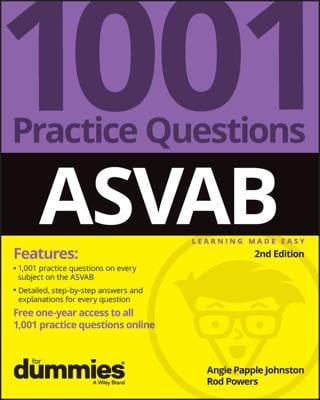The ASVAB will test your vocabulary. Usually, on the Word Knowledge subtest, you know the answer at first glance or you don’t. Even with that restriction, however, you can pick up a few tricks to help you get the best score possible.
Keep an eye on the clock
Like all the ASVAB subtests, the Word Knowledge subtest is timed. On the paper version, you have 11 minutes to answer the 35 questions, which means that you have slightly less than 20 seconds to answer each question. On the CAT-ASVAB, you have 16 questions in 8 minutes, giving you 30 seconds for each question. These amounts are plenty of time as long as you stay focused.
If you’re taking the computerized version of the ASVAB, your remaining time appears on the computer screen. If you’re taking the paper version of the test, a clock is clearly visible in the room, and the test proctor posts the start and stop time for the subtest on a blackboard or whiteboard.
Watch out for the evil homonym
A homonym is a word with more than one meaning. The word may be spelled the same or it may be spelled differently. If it’s spelled the same, it may have a different pronunciation. Some homonyms spelled differently can have the same pronunciation.
The ASVAB doesn’t contain any trick questions. In other words, the test doesn’t present you with two legitimate answers and ask you to try to decide which one is the “best.” However, homonyms can still trip you up if you don’t pay attention. Look at the following example:
Bate most nearly means:
(A)tease
(B)lessen
(C)treasure
(D)pregnant
Bate and bait are homonyms. They’re two words that sound the same, but they’re spelled differently and mean different things. Bait means to torment or tease (it’s also used to entice fish), and bate means to make less.
Some homonyms are spelled the same but have different meanings. You won’t see multiple correct definitions on the Word Knowledge subtest when you’re doing a direct definition problem, but you may see such multiple correct definitions when the word is used in the context of a sentence. For example:
Jack tied a bow around his neck.
(A)knot
(B)weapon
(C)ship front
(D)triangle
All the answer choices are proper definitions for the word bow. However, only one choice makes sense for bow in the context of the sentence. It just wouldn’t make sense for Jack to tie a weapon, front of a ship, or triangle around his neck.
Consider guessing
Sometimes on the Word Knowledge subtest, you just don’t know the answer. In that case, don’t leave it blank. The paper version of the ASVAB doesn’t penalize you for wrong answers. If you leave the answer blank, you have a 0 percent chance of getting it right. But if you make a wild guess, you have a 25 percent chance of stumbling upon the right answer.
However, on the CAT-ASVAB, you may want to make sure your guesses are educated and spaced out. Those pesky test graders have programmed the grading software to issue a pretty hefty penalty for multiple wrong answers toward the end of your subtests. They figure this scenario implies you were running out of time and didn’t read the questions.
Keep in mind that although you may know the word in the question, you may not know one or more of the words in the multiple-choice answers. In that case, use process of elimination to narrow your choices. Eliminate the words you know aren’t correct, and guess which of the remaining words is most likely correct.
Before making a wild guess, take a few seconds and look at the word from a different perspective. You may find that you know the word after all — just in a different form. In English, one root word can be changed slightly to perform all sorts of roles — it can act as a noun, a verb, an adjective, or an adverb with just a little modification.
So if you know what the root word attach means, you can figure out what the word attachment means. If you know adherent, you can deduce what adherence means.
You can use root word clues to identify unfamiliar words on the ASVAB. Say you run across the word beneficent on the Word Knowledge test:
Beneficent most nearly means:
(A)kind
(B)beautiful
(C)unhappy
(D)troubled
If you don’t have a clue what the word beneficent means, all is not lost. Take a closer look. What other word starting with the letters benefi- do you know? How about the word benefit? A benefit is something that helps or aids, so the word beneficent is likely related. So when you look over the possible choices, you can choose the one that has something to do with helping.
But wait. None of the answers says help or aid. Now what? Just use process of elimination. If something is helpful (beneficent), it probably isn’t troubled or unhappy. It may be beautiful, but more likely, it’s kind. So the best answer is Choice (A) — and it just so happens that that’s correct!

